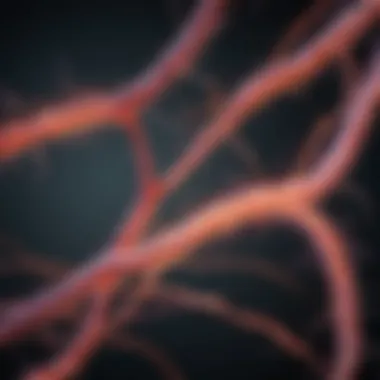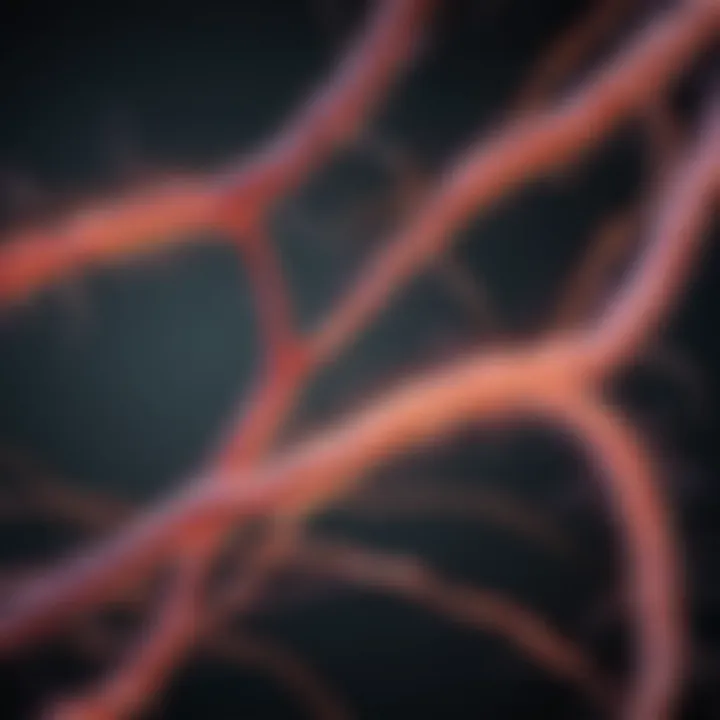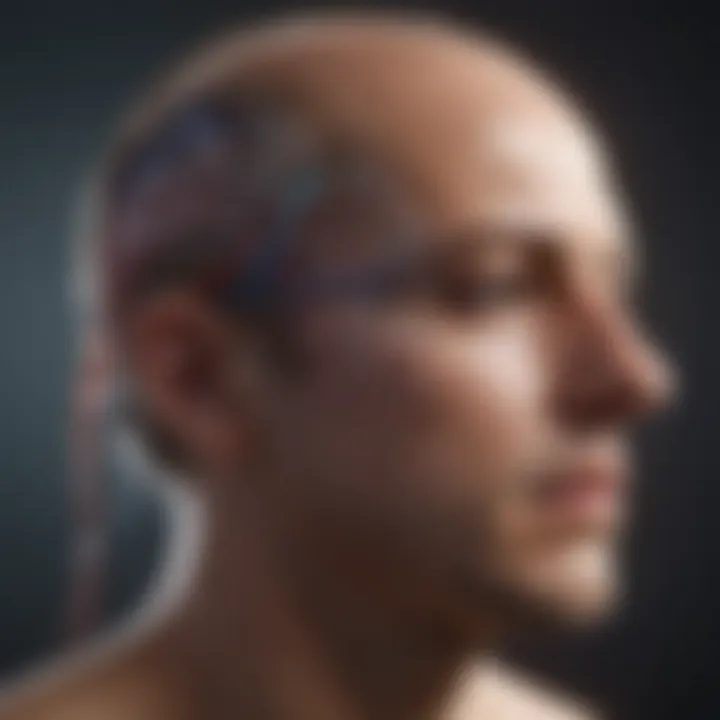Epilepsy and the Nervous System: A Comprehensive Review


Research Overview
Understanding epilepsy's multifaceted relationship with the nervous system is both a scientific pursuit and a necessity for effective treatment. This exploration reveals crucial insights into the neural mechanisms using various forms of empirical research. The complexity involved emphasizes how seizures—often viewed as disruptions—are, in fact, deeply intertwined with the brain's inherent functionality.
Key Findings
Recent research highlights several pivotal discoveries within this field:
- Neural Pathways: Epilepsy is primarily linked to abnormal electrical discharges in the brain. Studies show that specific neural circuits, like the hippocampus, play significant roles in seizure generation.
- Seizure Classification: Fifteen different seizure types have been identified, each with variable impacts on neurophysiology. The International League Against Epilepsy offers a comprehensive classification system to assist diagnosis.
- Genetic Factors: Emerging evidence suggests that genetic predisposition can significantly affect seizure threshold levels, highlighting a strong biological underpinning in epilepsy.
As researchers delve deeper, they uncover nuances that challenge existing consensuses and open pathways for innovative treatments.
Study Methodology
Investigative approaches often combine retrospective analyses and prospective cohort studies. Utilizing advanced imaging technologies, scientists can observe live brain activity during seizures, revealing patterns that were once elusive. Additionally, genetic analyses allow researchers to isolate specific genes correlated with epilepsy.
Background and Context
An understanding of the historical context surrounding epilepsy is crucial. While ancient texts describe seizures as mystical experiences, contemporary perspectives firmly anchor them in neurobiological foundations. Philosophers and physicians of the past contributed significantly to the evolving definitions and attitudes towards epilepsy. This culminated in increasing medical interest since the 19th century, which shifted focus to neurological explanations.
Historical Background
The first attempts to describe epilepsy date back several millennia. Hippocrates, often hailed as the father of medicine, proposed the natural origins of seizure disorders, laying foundational thoughts for modern understanding. Over time, breakthroughs followed, with the introduction of the electroencephalogram (EEG) in the 20th century marking a notorious highlight. It provided an objective way to measure electrical activity in the brain.
Current Trends in the Field
Today, research on epilepsy is blooming with innovation.
- Lifestyle Influence: The role of diet and environmental factors is receiving considerable attention, with ketogenic diets showing promise for seizure control in specific populations.
- Wearable Technology: Devices that monitor physiological changes are becoming increasingly important, providing real-time data that could help predict seizures.
- Interdisciplinary Approaches: Collaboration among various scientific disciplines enhances understanding and treatment protocols, merging neurology, genetics, and behavioral sciences.
"The progress in our understanding of epilepsy may transform patient care paradigms, ultimately leading to marked improvements in quality of life."
The continuous exploration into the nexus of epilepsy and the nervous system not only informs academic inquiry but also has tangible implications for individuals living with this condition. By synthesizing historical insight with current research trends, we aim for a more nuanced understanding that could pave the way for future advancements.
Understanding Epilepsy
Understanding epilepsy is crucial for grasping the intricate relationship between this neurological condition and the nervous system. Epilepsy is more than just a set of seizures; it’s a complex disorder that can deeply affect an individual's life. Thus, a thorough examination helps in recognizing its broader implications, including mental health challenges, societal perceptions, and implications for treatment. This section aims to provide insights that benefit not only those affected by the condition but also caregivers, healthcare professionals, and anyone seeking to understand its far-reaching effects.
Definition and Historical Context
Epilepsy is often described as a chronic disorder characterized by recurrent seizures. These seizures arise from abnormal electrical activity in the brain. The term itself has roots in the Greek word "epilambanein," meaning "to seize or attack." Historically, epilepsy was shrouded in superstition and considered a divine punishment or possession by spirits. Ancient civilizations, such as the Greeks and Romans, had varied interpretations, often attributing seizures to supernatural forces.
As time progressed, the understanding of epilepsy evolved. The advent of modern medicine has brought significant changes. The late 19th century saw breakthroughs in the study of the nervous system, which paved the way for better diagnoses and treatments. Facts and research moved beyond mysticism and formed a considerable body of knowledge. Today, medical science classifies epilepsy through various syndromes, emphasizing the need for precise diagnosis that often includes imaging and genetic assessments.
Prevalence and Epidemiology
Epilepsy isn’t just a condition that affects a few unlucky individuals. It's estimated that around 50 million people worldwide live with epilepsy, making it one of the most common neurological disorders.
- Global Prevalence: Studies have shown that its prevalence can vary depending on region, age, and other demographic factors. In low- and middle-income countries, it is often poorly diagnosed due to limited healthcare resources.
- Age Factors: The impact of age on prevalence is clear. While it can occur at any age, the highest rates are typically seen in children and older adults. For instance, childhood epilepsy syndromes are distinct and differ from those seen in older populations.
- Gender Considerations: There are gender effects too. Males generally face a higher prevalence compared to females, particularly in certain types of epilepsy, such as those that are genetically influenced.
"Epilepsy can affect anyone, anywhere. Understanding its prevalence equips societies to provide better resources, education, and support for those impacted."
Moreover, societal attitudes towards epilepsy vary greatly. In some cultures, a lack of understanding fosters stigma, affecting individuals' quality of life. Addressing these epidemiological aspects is essential for advocating for better healthcare strategies and policies around the world. Understanding the prevalence and demographics associated with epilepsy allows healthcare providers to tailor interventions that effectively meet the needs of diverse populations.
The Nervous System: An Overview
The intersection of epilepsy and the nervous system acts like a complex map where understanding each route leads to better comprehension of the whole picture. The nervous system plays a pivotal role not only in the emergence of seizures but also in how they affect individuals on a day-to-day basis. By examining its structure and function, we can unlock insights that inform effective treatments and management strategies for those living with epilepsy.
Structure of the Nervous System
Central Nervous System
The Central Nervous System (CNS) is akin to the main hub of an airport, coordinating all activities and responses in the body. This section encompasses the brain and spinal cord, encapsulating the machinery that processes information and coordinates response actions. One key characteristic of the CNS is its protective covering; bone encases vital components to shield against injury. This does not just preserve the brain's integrity but also maintains its ability to function optimally, which is crucial when epilepsy alters normal neuronal firing.
A unique feature of the CNS is its neuroplasticity, or the brain's remarkable ability to adapt and reorganize itself in response to new experiences. This provides a double-edged sword; while it can help in recovery post-seizures, it may also foster the persistence of abnormal neuronal connections, potentially aggravating seizure activity. Understanding the structure and functions of the CNS lays the groundwork for effective treatment pathways.
Peripheral Nervous System
The Peripheral Nervous System (PNS) can be seen as the wide network of telephone lines extending from the central hub. It’s responsible for transmitting signals between the CNS and the rest of the body. A key characteristic of the PNS is its distinct branches: motor and sensory pathways. This division allows the PNS to effectively respond to environmental stimuli or execute voluntary movements, two aspects critical for individuals coping with epilepsy.


One unique feature of the PNS is its regenerative capacity — damaged nerves can often heal or regenerate over time. This advantage serves as a beacon of hope for patients whose condition may have damaged peripheral pathways. However, it's also notable that the PNS is more vulnerable to injuries and diseases that can hinder its function. This balance of strengths and weaknesses within the PNS highlights its integral role in managing epilepsy.
Neurons and Their Function
Types of Neurons
Neurons are the building blocks of the nervous system, with various types each fulfilling specialized roles. Understanding the types of neurons — such as sensory neurons, motor neurons, and interneurons — is vital to grasp how seizures manifest and spread.
A distinctive characteristic here is the sensory neuron’s role in relaying information from the body to the CNS, such as detecting signals from the environment. This is crucial in managing epilepsy since triggers can frequently originate in external stimuli. Knowing the differences between neuron types empowers researchers and clinicians to tackle challenges posed by epilepsy more effectively. However, the boundary between neuron types can sometimes blur, making a clear classification difficult, complicating treatment options further.
Neuronal Communication
The signal relay among neurons, known as neuronal communication, resembles a high-speed relay race, where information zips from one neuron to the next. This process is vital in maintaining brain function and thickens the narrative of epilepsy because when this communication falters, seizure activity often ensues.
One significant characteristic of neuronal communication is synaptic transmission. This process ensures that neurotransmitters travel across synapses to connect different neurons, thus facilitating communication. Moreover, the efficiency of synaptic connections can increase through experience, a phenomenon termed synaptic plasticity. While this adaptability helps with learning and memory, it can also create pathways that may contribute to increased seizure likelihood in susceptible individuals. The delicate equilibrium of neuronal communication plays a vital role in both understanding and treating epilepsy effectively.
Neurophysiology of Epilepsy
Understanding the neurophysiology of epilepsy is crucial for anyone delving into this subject. It provides a window into the brain's inner workings and how those workings can go awry. The essence of epilepsy is rooted in abnormal electrical activity within the brain. These disruptions can manifest themselves as seizures, which have a profound effect not only on individuals experiencing them but also on the broader database of neurological health.
Diving into this area, we observe two key dynamics: hyperexcitability and neuronal network dynamics. Each of these elements contributes uniquely to the generation of seizures. Grasping these concepts enables a deeper understanding of the underlying mechanisms that characterize epilepsy, which is imperative for treatment and management.
Mechanisms of Seizure Generation
Seizures do not just appear out of thin air; they stem from particular physiological processes that can be categorized under two headers: hyperexcitability and neuronal network dynamics.
Hyperexcitability
Hyperexcitability refers to an increased likelihood of neurons firing more easily than normal. This state is crucial for understanding epilepsy because it serves as a primary trigger for seizures. In a healthy brain, neurons communicate with a level of balance. Think of it like a finely tuned orchestra where each section plays its part cohesively. However, hyperexcitability acts like that one overly enthusiastic musician who keeps hitting the wrong key, throwing the whole composition off balance.
A key characteristic of hyperexcitability is the dysfunction of ion channels. When these are not functioning properly, it leads to an excessive influx of ions into the neuron, which can result in repetitive firing. For our discussion on epilepsy, this aspect is essential because it highlights the biological basis for seizure occurrence.
The unique feature of hyperexcitability lies in its ability to contribute to both focal and generalized seizures. While it’s often targeted for drug therapies, its contribution to seizure generation also illustrates one of the complexities of treatment. An advantage of focusing on hyperexcitability is that by identifying its triggers, medical professionals can tailor interventions better to mitigate seizure frequency.
Neuronal Network Dynamics
Neuronal network dynamics speaks to the interconnectedness of brain cells and how they operate together. When considering epilepsy, it's essential to realize that seizures arise not only from individual neuron activity but also from how those neurons sync their activities across networks. For many, it’s a group dance—when one neuron starts to misbehave, its partners can follow suit.
A key characteristic of neuronal network dynamics is the concept of network excitability. When the network becomes excessively excitable, it can lead to widespread seizure activity, much like a wildfire spreading through a forest. This interconnectedness also brings about unique challenges; while targeting individual neurons may yield results, addressing the network's dynamic behavior can be quite the uphill battle.
Advantages of focusing on network dynamics include:
- Broader understanding of seizure propagation
- Insights into potential new treatment targets that go beyond merely dampening hyperexcitability
Types of Seizures
Seizures are not a monolith; they come in various forms that can be categorized primarily into two groups: generalized and focal seizures. Understanding these distinctions is pivotal in both diagnosis and management.
Generalized Seizures
Generalized seizures affect both hemispheres of the brain simultaneously. This means that the abnormal electrical activity spreads quickly and comprehensively. The diversity of symptoms can range from loss of consciousness to pronounced muscle contractions or even subtle signs like staring blankly. One might say this type lays down a blanket over the brain, resulting in an all-encompassing effect.
A hallmark of generalized seizures is their sudden onset, often without warning. This unpredictability can significantly impact a person's quality of life.
Advantages of recognizing generalized seizures include:
- Timely interventions can be initiated.
- Better understanding and communication with caregivers and family members.
Focal Seizures
Conversely, focal seizures begin in a localized region of the brain, meaning they may present with distinct symptoms depending on where the abnormal activity originates. For instance, a focal seizure occurring in the temporal lobe could trigger alterations in memory or awareness. It’s like tuning into a specific channel on the radio rather than listening to a broad broadcast.
A unique characteristic of focal seizures is that they can evolve into generalized seizures. This transformation may occur if the localized activity spreads, highlighting the interconnected nature of brain functions.
The advantages of pinpointing focal seizures include:
- Targeted treatments can be developed, as the origin can be identified.
- Patients may find more manageable symptom patterns leading to a unique personal seizure profile.
In summary, understanding both the mechanisms of seizure generation and the types of seizures provides a comprehensive insight into epilepsy. This knowledge is instrumental for devising more effective diagnostic and therapeutic avenues.


Diagnostic Approaches
Understanding the diagnostic approaches to epilepsy is crucial in unraveling its complexities. An accurate diagnosis serves as the cornerstone for effective treatment options. This section aims to discuss the various diagnostic methods used in evaluating epilepsy, focusing on their significance, benefits, and any considerations that may arise with each approach.
Clinical Evaluation
Patient History
The patient's history is often considered the first step in diagnosing epilepsy. It involves gathering detailed information about the individual's past medical issues, previous seizures, triggers, and any family history of epilepsy. This aspect is pivotal since it helps in piecing together a broader picture of the patient's health and identifying potential patterns or triggers in seizure occurrence.
A key characteristic of patient history is its comprehensive nature; it doesn't just focus on seizures but looks at the whole life context. This makes it a popular choice in clinical settings, as doctors get insights into the patient's lifestyle, stressors, and environmental influences that might affect epilepsy. A unique feature of this approach is that it allows for a more personalized assessment, enabling healthcare providers to tailor their approach effectively. However, it's also worth noting that relying solely on historical accounts can lead to misinterpretations; patients may forget details or misreport their experiences, which can complicate the diagnosis.
Physical Examination
Physical examination remains a vital method in the diagnostic process. It involves assessing the patient's overall neurological functioning, reflexes, and motor abilities. This approach is beneficial as it helps rule out other conditions that may mimic epilepsy, such as migraines or movement disorders.
A notable characteristic of physical examinations is their immediate feedback; doctors can often acquire insights on impulse control, cognitive functions, and reflexes that inform further testing. Considering this, many clinicians advocate for its inclusion in the diagnostic process alongside patient history. However, one unique aspect is that a normal physical exam does not exclude the possibility of epilepsy; some patients may exhibit no physical signs yet still experience seizures due to electrical disturbances in the brain.
Neuroimaging Techniques
MRI
Magnetic Resonance Imaging (MRI) serves as a powerful tool in visualizing brain structures. It's particularly important for identifying abnormalities that could contribute to seizure activity, such as tumors, vascular malformations, or developmental anomalies. MRI has become a cornerstone in the diagnostic toolkit due to its detailed imaging capabilities.
The key characteristic that sets MRI apart is its non-invasive nature and the high quality of images it produces. For this article, it stands out as a beneficial choice, providing clear insights into brain morphology and helping clinicians formulate appropriate management strategies. A unique feature of MRI is that it can detect subtle changes in brain structure that other modalities might miss. However, it has some disadvantages, like the time required for imaging and the need for patients to remain still, which may be challenging for those experiencing anxiety.
CT Scans
Computed Tomography (CT) scans are often used when MRI is not readily available or when rapid assessment is needed, such as in emergency situations. CT provides a quicker alternative to visualize the brain, helping to identify, for instance, bleeding or acute injuries that may cause or mimic seizures.
A key distinguishing feature of CT scans is their speed; they can offer initial insights rapidly, which is crucial in acute care settings. This advantage makes them a popular option, especially when time is of the essence. Still, unlike MRI, CT provides lower-resolution images and is less effective in distinguishing subtle abnormalities, which might pose risks in chronic epilepsy diagnosis and management.
Electroencephalography (EEG)
Electroencephalography (EEG) is a key diagnostic tool that records the electrical activity of the brain. This method is fundamental in epilepsy diagnosis, as it detects abnormal electrical discharges that characterize seizure activity. Clinicians often rely on EEG data to confirm an epilepsy diagnosis and understand seizure patterns.
EEG is unique as it can capture real-time activity and is less invasive compared to structural imaging techniques. Its ability to reveal seizure focus locations and types is vital for treatment decisions. However, one must consider that EEG findings can be influenced by various external factors, including stress, sleep deprivation, or medications, which may affect accuracy. Understanding the role of EEG and its implications in the context of epilepsy diagnosis is critical for those in the field.
Treatment and Management Strategies
When it comes to tackling epilepsy, the approach often requires a multi-faceted strategy that encompasses both pharmacological and non-pharmacological interventions. The significance of this topic lies not only in the diverse nature of treatments available but also in how these strategies intersect to improve the quality of life for affected individuals. By understanding the variety of options, patients, caregivers, and healthcare providers can make informed decisions tailored to the unique needs of each person struggling with this condition.
Pharmacological Interventions
Antiepileptic Drugs
Antiepileptic drugs (AEDs) play a pivotal role in controlling seizures and are the frontline treatment for epilepsy. These medications are designed to stabilize electrical activity in the brain and often target specific neurotransmitter systems. One of the standout features of AEDs is their ability to be tailored to various seizure types, allowing for more personalized treatment plans.
For instance, drugs like lamotrigine or carbamazepine may be prescribed depending on whether a patient experiences focal or generalized seizures. The key characteristic of these drugs is their efficacy in reducing the frequency and intensity of seizures, thus allowing many individuals to lead near-normal lives.
However, there are advantages and disadvantages to consider. While AEDs can successfully manage seizures for many, they are not without side effects. Some patients may experience drowsiness, dizziness, or cognitive changes, which can impact their daily functioning. Therefore, it’s essential to monitor patients closely and adjust medications as needed to balance efficacy with quality of life.
Benzodiazepines
Benzodiazepines, such as diazepam or lorazepam, serve a different purpose in the treatment landscape for epilepsy. They are primarily used for acute seizure management but can also be part of long-term care in specific situations, known as rescue medications. The key characteristic that makes benzodiazepines particularly valuable is their rapid onset of action, which is crucial during seizure emergencies.
The unique feature of benzodiazepines lies in their ability to enhance the effect of a neurotransmitter called GABA, which has a calming effect on brain activity. This rapid relief can be life-saving in situations of prolonged seizures. Nonetheless, reliance on benzodiazepines also has its pitfalls. Long-term use can lead to tolerance and dependency, making it a double-edged sword in epilepsy treatment.
Non-Pharmacological Interventions
Surgery
For some individuals, especially those whose seizures are not well controlled by medications, surgery might be an option. Surgical interventions aim to remove the area of the brain where seizures originate, such as in cases of temporal lobe epilepsy. The key characteristic of surgery is its potential to completely eliminate seizures for qualified candidates, providing a chance for a seizure-free life.
One significant advantage of surgery is the improvement in the overall quality of life; many patients report enhanced cognitive function and emotional well-being post-surgery. However, it’s not without its disadvantages. Surgery comes with risks associated with any invasive procedure, and not all patients are suitable candidates based on the location and nature of their seizures. Therefore, thorough evaluations and consultations are necessary before proceeding with this intervention.
Neuromodulation Techniques
Neuromodulation techniques, including responsive neurostimulation and vagus nerve stimulation, represent innovative approaches to managing epilepsy, especially when traditional treatments falter. The key characteristic of these methods is their ability to modify nerve activity using electrical impulses, aiming to reduce seizure frequency.


The unique feature of neuromodulation is its adaptability; devices can be fine-tuned to cater to individual responses, offering a tailored management option. Additionally, since these techniques are typically less invasive than surgery, they pose fewer risks while still providing a measurable impact on seizure control. On the flip side, neuromodulation may not be suitable for every patient, and accessibility to such technologies can vary.
Lifestyle Modifications
In addition to medical interventions, lifestyle modifications play a crucial part in managing epilepsy. These changes might include optimizing sleep, reducing stress, and avoiding known seizure triggers like excessive alcohol consumption or specific flashing lights. Incorporating a holistic approach can vet significant benefits, while also empowering patients in their journey toward better seizure management.
Genetic Factors in Epilepsy
Understanding the genetic factors related to epilepsy is crucial, as it not only provides insights into the underlying causes of the condition but also paves the way for tailored treatment options. Epilepsy can be influenced by genetic mutations, inherited conditions, and even environmental factors that interact with these genetic components. Research indicates that genetic predisposition can significantly affect the type of epilepsy a person has, the severity of the seizures, and the response to treatments. This understanding is particularly relevant as it allows for personalized management strategies, enabling better outcomes for individuals afflicted by the disorder.
The acknowledgment of genetic factors in epilepsy underscores the necessity for research that intertwines genetics and neuroscience. As we make advances in our understanding, we arrive at the realization that better therapies may hinge on knowledge of an individual’s genetic makeup.
Hereditary Epilepsy Syndromes
Hereditary epilepsy syndromes exemplify how genetics play a direct role in epilepsy. These syndromes can often be traced back to specific genetic defects that are transmitted from parents to their children.
- Dravet Syndrome: This rare severe form of epilepsy occurs due to mutations in the SCN1A gene. Characteristics often include prolonged seizures starting in the first year of life. Children with Dravet may also show cognitive decline over time.
- Lennox-Gastaut Syndrome: Another severe form, often arising from various genetic issues, presents itself with multiple seizure types and cognitive impairment.
- Benign Childhood Epilepsy with Centrotemporal Spikes (BECTS): Contrary to the previous syndromes, BECTS is often milder and associated with good prognosis. It's typically seen in children and has a genetic basis in some cases.
An important takeaway is the variable expressivity, meaning that even siblings with the same genetic mutation might experience different symptoms or severity levels. This variability suggests that while genes play a role, other factors such as environment or additional genetic modifiers can influence the expression of epilepsy.
Genetic Testing Approaches
As the field of medical genetics has evolved, genetic testing has become an important tool in diagnosing and managing epilepsy. Genetic testing can help identify changes in genes that might inform treatment decisions or offer insights into familial inheritance patterns. There are different approaches to genetic testing:
- Targeted Gene Panels: These tests focus on specific genes previously linked to epilepsy syndromes. It's a more straightforward approach that aids in rapid diagnosis.
- Whole Exome Sequencing (WES): This broader approach analyzes all coding regions of genes and can uncover unexpected mutations not listed in specific panels.
- Chromosomal Microarray Analysis: This technique can identify larger chromosomal abnormalities which may contribute to epilepsy.
The process involves collecting DNA from blood or saliva samples, making it a non-invasive method. With the knowledge gathered from genetic testing, families can better understand the risks of inheritance and potentially guide therapeutic interventions. Genetic counseling is often recommended alongside testing to help families make sense of the results. With this lens, individuals can face their diagnosis with knowledge and clarity, navigating their journey through epilepsy more effectively.
Understanding the genetic factors in epilepsy provides the keys toward unlocking its mysteries.
In summary, exploring the genetic dimensions of epilepsy is invaluable for advancing patient care and treatment options. Not only does it enhance our understanding of the condition, but it also beckons more comprehensive studies and collaborations between geneticists, neurologists, and other specialists as they work towards better management and outcomes for those affected by epilepsy.
Impact on Quality of Life
Understanding the impact of epilepsy extends beyond the clinical aspects; it seeps into the very fabric of daily existence for those living with the condition. Quality of life can be significantly altered due to the myriad challenges faced by individuals with epilepsy. The psychosocial elements and coping strategies employed play crucial roles in managing this condition. Hence, it's vital to explore how epilepsy intertwines with quality of life to foster not only better medical outcomes but also enhanced well-being for affected individuals.
Psychosocial Aspects
Epilepsy often comes with a cultural stigma that informs the way society perceives and treats those affected by this disorder. Fear, misunderstanding, or even pity can lead to social isolation or diminished self-esteem for individuals living with epilepsy. According to many studies, those with epilepsy report high levels of anxiety and depression, which can further complicate their day-to-day lives.
For instance, some people may feel anxious about having a seizure in public, which can hinder their willingness to participate in social activities. Their interactions may become limited, leading to a sense of loneliness. Notably, relationships with family, friends, and coworkers can suffer as misunderstandings about seizure episodes occur. Building a supportive social network is essential, as it has been found that emotional support can alleviate some psychosocial burdens. Direct conversations with friends and family regarding the condition often promote understanding and acceptance, fostering stronger connections.
"Living with epilepsy is not just about managing seizures but also navigating the many social waters that come with it."
Coping Strategies
To navigate life effectively while living with epilepsy, employing various coping strategies is essential. Effective coping can transform the challenges posed by this condition into manageable aspects of life. Here are some strategies that can be particularly beneficial:
- Education: Understanding epilepsy, its triggers, and potential impacts on daily life arms individuals with the knowledge needed to avoid pitfalls and advocate for themselves.
- Routine Establishment: Keeping a consistent daily routine can minimize stress and improve seizure management. Regular sleep patterns, meal times, and medication schedules can help.
- Mindfulness Practices: Numerous individuals find solace in practices such as meditation or yoga. These activities help reduce anxiety and may limit the frequency of seizures in some cases.
- Community Engagement: Support groups, whether online or in-person, offer platforms for sharing experiences and gaining insights. Connecting with others facing similar challenges can instill a sense of belonging.
- Professional Help: Engaging with mental health professionals can provide tailored strategies for managing stress and anxiety, allowing for healthier emotional expression and resilience enhancement.
Addressing the psychosocial complexities of epilepsy is as crucial as treating the medical aspects. By focusing on both sides, we can work towards improving the quality of life for those affected by this condition. The various coping strategies mentioned can create a roadmap to navigate life's challenges more smoothly, fostering resilience and well-being.
Future Directions in Research
Research into epilepsy and its relationship with the nervous system is a rapidly evolving field. As our understanding of this complex neurological condition deepens, several promising avenues for future inquiry emerge. The significance of this research not only lies in the potential for novel treatments but also in enhancing the overall quality of life for those affected by epilepsy. Here, we delve into two essential areas: emerging therapies and interdisciplinary approaches.
Emerging Therapies
The landscape of epilepsy treatment is steadily shifting, driven by the need for more effective and individualized interventions. One area capturing significant attention is the development of novel antiepileptic drugs (AEDs). These therapies aim to target specific neural pathways disrupted in epilepsy rather than adopting a one-size-fits-all approach.
Key components of emerging therapies include:
- Cannabidiol (CBD) Oil: Gaining traction for its potential efficacy in reducing seizure frequency for certain types of epilepsy, especially in children.
- Gene Therapy: This approach holds promise in dealing with genetic forms of epilepsy, where specific genes can be targeted for correction, potentially stopping seizures at their source.
- Blockchain in Health Records: Using blockchain technology is turning out to improve patient data management, enhancing personalized treatment approaches.
As these novel therapies come to light, clinical trials will play a crucial role. They help researchers evaluate the effectiveness and safety of new drugs and implementations. Patients now have hope more than ever that future treatments could align more closely with their specific types of epilepsy and individual responses.
"An overreliance on traditional therapies has overshadowed groundbreaking advancements, making research into novel treatments essential for change."
Interdisciplinary Approaches
In tackling epilepsy, it's becoming clear that an interdisciplinary approach can yield more comprehensive solutions. Merging insights from various fields creates a holistic understanding of this condition that could lead to innovative diagnosis and treatment strategies.
- Collaboration Between Neurologists and Geneticists: Neurologists are increasingly working alongside geneticists to understand hereditary epilepsy better. This synergy allows for personalized treatments based on genetic makeup, thus addressing the root causes of seizures.
- Psychology and Neuroscience Collaboration: Understanding the cognitive and emotional ramifications of epilepsy can significantly enhance patient care. By integrating psychological methodologies with neurological treatments, healthcare providers can devise effective coping strategies for the mental health challenges that frequently accompany epilepsy.
- Technology Integration: The utilization of wearable devices, like smartwatches that monitor seizure activity, demonstrates the intersection of technology and medicine. These devices can provide real-time data, aiding healthcare professionals in making timely decisions about treatment adjustments.
By embracing the collaboration of multiple disciplines, the fight against epilepsy can be more comprehensive, addressing not merely the seizures but the broader impact on users’ lives. The diverse perspectives provided by interdisciplinary teams may lead to groundbreaking discoveries that can fundamentally change how epilepsy is understood and managed.







